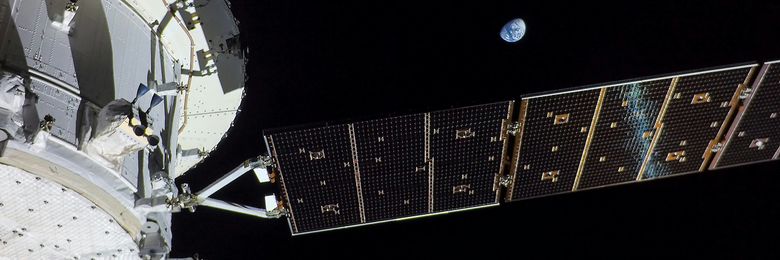An integral part of NASA’s Artemis mission
More than 50 years after the first crewed Moon landing in 1969, the US Space Agency NASA is setting out once again to visit Earth´s satellite - not just for a few days only, but to establish the foundations for a permanently crewed human outpost in the long term. Under its Artemis programme, with its first launch in 2022, NASA is planning to return to the Moon with a landing on its surface scheduled for 2027.
Europe and Airbus are playing a major role in this ambitious project, for the first time ever, NASA has entrusted a non-US company to build a mission-critical element for a US Human Spaceflight Mission.
Under a European Space Agency (ESA) contract, Airbus is responsible for building the European Service Module (ESM), which both propels and manoeuvres the Orion spacecraft and provides the crew with water and oxygen, as well as regulating thermal control.
The Orion spacecraft consist of two main parts: the Crew Module, which is the habitat for up to four astronauts and their cargo, and the Service Module - built at the Airbus facility in Bremen. The two modules are attached and connected via the Crew Module Adapter.
Together, they form the Orion spacecraft

Going back to the Moon couldn’t happen without us
ESA contracted Airbus to build 6 European Service Modules. And we are already discussing modules 7, 8 and 9 with ESA.
Over 150 engineers from 10 countries have crafted the ESM together with ESA and industry partners, starting from Airbus’ experience gained on the Automated Transfer Vehicle (ATV), which flew 5 times to the ISS.
Building the ESM modules in quick succession means adjusting the cleanroom facilities at the Bremen site with the ambition to deliver one ESM per year.

Successful un-crewed Artemis I mission with ESM-1 ‘Bremen’
Launched on 16 November 2022, the Orion spacecraft with the first ESM-1 module - christened ‘Bremen’ - spent 25 days, 10 hours, 53 minutes travelling to and over 70,000 km beyond the Moon, before the Crew Module splashed back down in the Pacific Ocean on 11 December 2022.
This uncrewed test mission was a tremendous success with all mission objectives fully achieved. It also provided a tremendous source of information for future missions.

ESM-2 delivered for first crewed Orion mission
The second ESM was flown from Bremen to Kennedy Space Center on an Antonov cargo aircraft in October 2021.
The Artemis II Mission will fly 4 astronauts, NASA astronaut commander Reid Wiseman, pilot Victor Glover, mission specialists Christina Koch and Canadian Space Agency astronaut Jeremy Hansen, around the Moon and back to Earth. The crew will fly Orion to 8,889 km beyond the Moon before completing a lunar flyby and returning to Earth.

ESM-3 shipped to Cape Canaveral for Moon landing
Orion's ESM-3 was delivered to NASA's Kennedy Space Center in summer 2024, to be assembled and tested with the Crew Module. This third mission will mark the first human return to the lunar surface since Apollo 17 in 1972.
The ESM-3 will play a critical role in supporting 4 astronauts during their 3-week mission: from the moment they leave Earth’s orbit, through their journey into lunar orbit, docking with the Human Landing System (HLS) in lunar orbit, and their safe return to Earth.

Building of ESM-4 to ESM-6 at Airbus Bremen cleanroom
The fourth ESM will propel the Orion spacecraft of the Artemis IV mission into the correct orbit to dock with the Gateway space station and enable the astronauts to enter their new living space. This mission will also transport the main habitation module of the lunar space station.
At the Bremen site we have adjusted our cleanroom facilities with the ambition to deliver one ESM per year - a production rate unheard of for human-rated spacecraft in Europe.
Back to the Moon to stay and venture onward
The first Artemis Missions will pave the way for humans to continuously live on the Moon. On their missions, the Artemis astronauts will investigate its surface and learn how to live and work there.
While the Moon is conveniently close to Earth, it also provides the resources needed for reaching destinations beyond - making it an ideal point of origin to prepare for the next ‘giant leap’: human exploration of Mars.
The creation of a continuous human presence on the Moon will be crucial to building up operational experience in reliably supporting life away from Earth. It will build the confidence needed for conducting long-term missions, before multi-year human missions to Mars can be envisaged in the future.
-


-

Going back to the Moon couldn’t happen without us
50 years after their last visit, humans will soon land on the Moon again. Why the historic mission would not be possible without Airbus - hand in hand with the European Space Agency - and how it could enrich our lives on Earth - Guillaume Faury, Mike Schoellhorn and Jean-Marc Nasr exclusively provide all the details.
The latest Orion news
In the spotlight
-
 Stories Space
Stories SpaceOrion’s European Service Module 3, the backbone of return to the Moon
Orion's third European Service Module (ESM-3) is leaving Airbus' facilities in Bremen, Germany, and heading to NASA's Kennedy Space Center in Florida, where it will be assembled and tested with the… -
 Press releases Space
Press releases SpaceAirbus ships the third European Service Module to Cape Canaveral on behalf of ESA
-
 Stories Space
Stories SpaceArtemis II astronauts discover a key component of the Orion spacecraft
-
 Stories Space
Stories SpaceArtemis I successfully launched: Orion is heading to the Moon with Airbus’ European…


















